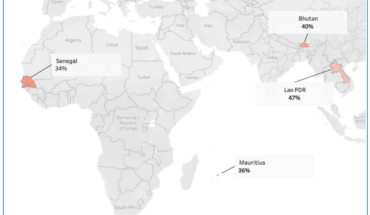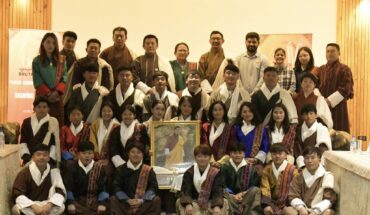
KINZANG DORJI TSHERING
Thimphu
The agriculture and livestock sectors have registered modest yet significant growth in the past year, according to findings from the Integrated Agriculture and Livestock Census of Bhutan 2025 (IALC 2025), released by the National Statistics Bureau (NSB) in June. The nationwide census, conducted from January 1 to February 20, involved 661 field enumerators covering every dzongkhag and chiwog across the country. The report offers a detailed account of Bhutan’s food systems, crop yields, livestock dynamics, and institutional holdings, providing a critical data foundation for policy planning and food security strategies.
The census covered a total of 70,278 agricultural holdings, comprising both crop growers and livestock holders. Of these, 99 percent were household-based, while the remaining 1 percent was institutional or commercial entities, such as cooperatives, monasteries, schools, and state-owned enterprises. The results confirm the continuing importance of smallholder agriculture in Bhutan’s economy and social fabric. Household farms remain the backbone of crop and livestock production, often combining traditional practices with limited mechanization, and producing largely for local markets or subsistence.
The 2025 edition marks the third such census conducted under the NSB since 2021, following an executive order transferring the responsibility from the Ministry of Agriculture and Livestock. The consolidated format of the Integrated Agriculture and Livestock Census was introduced to streamline data collection, reduce duplication, and enable consistent reporting. This year’s census drew on digital tools, including Computer Assisted Personal Interviewing (CAPI), to improve data accuracy and enable real-time validation. Enumerators—comprising 489 Tshogpas, 172 Tshogpa Ngotshabs, and interns—were trained in December 2024 and deployed in early January for the main enumeration phase.
In terms of crop production, cereals continue to dominate the Bhutanese landscape, both in volume and in land use. The country produced 72,177 metric tonnes (MT) of cereals in 2024, marking a 4.92 percent increase over the 68,786 MT recorded the previous year. Paddy accounted for the largest share, with irrigated fields yielding 41,352 MT—up slightly from 2023. Upland paddy, however, declined by 23 percent to just 185 MT, attributed to a drop in cultivation in some highland areas.
Maize remained the second most important cereal, with production rising to 27,636 MT from a harvested area of 18,609 acres. Although the number of maize growers dropped from 38,456 in 2023 to 36,613 in 2024, productivity increased. Monggar led in maize production with over 5,949 MT, followed by Samtse and Sarpang. Other cereals like wheat (839 MT), barley (527 MT), millet (579 MT), buckwheat (1,019 MT), and quinoa (40 MT) contributed smaller shares but remained essential to food diversity, especially in dzongkhags like Trashigang, Lhuentse, and Bumthang.
Vegetable cultivation showed vibrant outputs in several categories. Chillies led the charts with 5,596 MT, highlighting their popularity and commercial value. Cabbage (2,305 MT), radish (2,194 MT), carrot (1,829 MT), and cauliflower (1,096 MT) were also major contributors. These crops were largely grown in the mid-hills and southern districts, where climate conditions and road connectivity support market-oriented farming. Beans, broccoli, onion, and tomato production also showed year-on-year gains. The total vegetable output signals the increasing trend of farmers diversifying away from cereals toward higher-value horticultural crops.
Fruits performed strongly as well, with mandarin oranges topping the list at 20,830 MT. Areca nut, often grown in southern Bhutan, followed with 14,405 MT. Apple production stood at 2,102 MT, reflecting the continued importance of temperate fruit farming in districts like Paro and Thimphu. The census also recorded modest yields of watermelon, kiwi, dragon fruit, and other niche crops, indicating experimentation and adaptation among fruit growers.
In the livestock sector, milk production reached 44,038 MT in 2024, reinforcing its status as the leading livestock product. Butter (1,695 MT), cheese (2,584 MT), and chugo (193 MT) also featured prominently in the dairy output. Egg production rose to 98 million, while meat production totalled around 5,800 MT, with pork (1,555 MT) and beef (1,271 MT) making up the bulk. Chicken meat accounted for 1,208 MT and fish for 210 MT. In addition, the country produced 55 MT of honey and 11 MT of wool.
The livestock population was recorded as of December 31, 2024, the census reference date. The data showed a balanced herd structure, with significant populations of improved cattle breeds such as Jersey and Brown Swiss, especially in regions with better infrastructure and market access. Local bovine breeds also remained dominant in the east and central highlands, where yaks and mithuns were found in higher numbers. Apiculture and aquaculture activities were recorded in 18 dzongkhags, with bee and fish farms supported by both government centres and private initiatives.
The NSB highlighted that production and herd estimates were cross-verified using multiple data validation tools. Data inconsistencies were flagged by digital forms and manually followed up by enumerators. Any missing or suspicious entries were reviewed by dashboard managers at headquarters, ensuring that quality control extended from the field to the final report.
Behind the statistics lies a much larger story of Bhutanese resilience and transformation. While the traditional household-based farming system still dominates, the census data shows a gradual shift toward commercialization, diversification, and technological adoption. Cooperatives, community groups, and state-run enterprises are beginning to shape production in meaningful ways. Institutions like the National Dairy Development Centre in Thimphu and the National Mithun Breeding Centre in Samdrup Jongkhar continue to contribute to breed improvement, genetic diversity, and higher yields.
In parallel, government farms operated under the Ministry of Agriculture and Livestock are expanding their reach. Facilities such as the National Yak Farm in Haa, the Trout Breeding Centre in Lhuentse, and the Apiculture Research Unit in Bumthang are not only improving production but also serving as training and innovation hubs. The data also captures activities in urban and peri-urban areas, pointing to a rising trend in backyard farming and rooftop gardening.
The 2025 census was carried out in accordance with international protocols, including the FAO’s World Programme for the Census of Agriculture. Bhutan’s use of the CAPI system reflects the country’s growing capacity for evidence-based planning. The NSB’s collaboration with the Ministry of Agriculture and Livestock, Dzongkhag Statistical Officers, local governments, and enumerators across the country demonstrated a coordinated approach to national data collection.
In its foreword, the NSB expressed hope that the census will inform future policy direction, aid in the formulation of investment strategies, and enhance food security planning. “This report is not just about numbers—it is about the lives of farmers and the future of our food systems,” the Director General stated. “We extend our deepest appreciation to all enumerators, local leaders, and especially the farming households who gave their time and trust to this national exercise.”
As Bhutan continues to face pressures from climate change, youth migration, and shifting consumption patterns, the IALC 2025 offers a timely and detailed snapshot of the country’s agricultural landscape. For policymakers, researchers, and development partners, the findings provide a vital foundation for designing targeted interventions that can boost productivity, strengthen rural incomes, and ensure food sovereignty in the years ahead.





